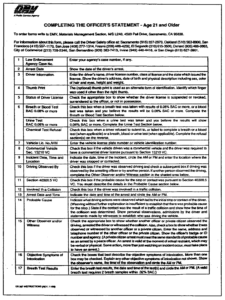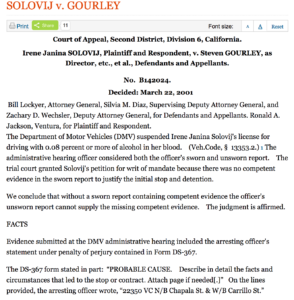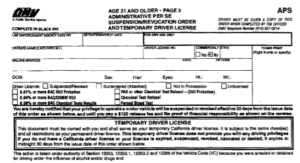What is valid probable cause in a DUI – Solovij v. Gourley
The de-published case of Solovij v. Gourley, (105 Cal. Rptr. 2d 278 – 2001), is a good illustration of what constitutes probable cause from the court, and from the DMV’s point of view.
Ms. Solovij was stopped and arrested for DUI in Santa Barbara. There was a DMV hearing for the DUI case, and at the DMV hearing, the DMV’s “Officer’s Statement” form, written by the arresting officer, was introduced.
The Officer’s Statement Form, or DS-367 form (DS for Driver Safety, form 367), which is a DMV form designed for and used for the DMV hearings in any DUI case, is a form designed to contain all the evidence from the police officer in a DMV hearing on one form. It makes the entire case, containing the date, time, location, observations regarding intoxication, probable cause for the DUI stop and arrest, and all blood test or breath test information obtained in the case. It also certifies that notice was given to the driver by serving the driver with the temporary license and notice of hearing rights.
Above is a blank Officer’s Statement form showing the information to be filled in by the officer.
The DS-367 form also, on page 3 of the form, acts as the Temporary Driver’s License and Suspension Order for the license-holder.
Even without a form, California Vehicle Code section 13380 expressly requires any arresting officer in a DUI case to file a sworn report containing “all information relevant to the enforcement action․” But with the information in the DS-367 Officer’s Statement form, if it is properly filled out, the DMV can make the entire case for a suspension without any other evidence – since the Officer’s Statement is sworn under penalty of perjury, it certifies all the relevant facts contained in the form. The police report, traffic collision results, and even the breath test could be missing, and the DMV would still have have enough information to suspend a driver’s license and driving privileges.
The DMV distributes blank triplicate DS367 forms to all law enforcement agencies in California. They also train officers through written instructions on what information goes in each part of the form. That is done through the “Completing the Officers Statement” memo, reproduced below, showing, “by the numbers”, which information goes where:

The “Completing the Officers Statement” instructions from the DMV, to law enforcement officers.
In the Solovij case, there was an Officers Statement submitted to the DMV in the case. The DMV DS-367 form stated in part:
“PROBABLE CAUSE. Describe in detail the facts and circumstances that led to the stop or contract․ Attach page if needed[.]”
On the lines provided, the arresting officer wrote only the following:
“22350 VC N/B Chapala St. & W/B Carrillo St.”
(22350VC is California’s basic speed law – meaning that the stop here was for speeding). The officer then signed, dated, and served the form, under penalty of perjury as to the facts involved.
The officer’s unsworn arrest report was also submitted as evidence. The arrest report stated in part:
“On 10/02/99 at approximately 0105 hours I was on routine patrol in a marked SBPD DDT unit, number 1892. I was driving northbound in the 800 block of Chapala Street. I observed a red 1993 Plymouth van, California license 3LMK096, passing vehicles as it was driving northbound and appeared to be driving at a speed in excess of the speed limit. As I continued to watch the vehicle and follow it until it made a stop at the intersection of Carrillo and Chapala, I noticed that as it was driving in the number one lane it appeared to be using all the lane, going from side to side. I sat behind the van as it waited for the red light and followed the van westbound on Carrillo Street where it continued to weave within its lane and I initiated a traffic stop in the 300 west block of Carrillo Street.”
The report introduces weaving as separate probable cause for DUI, although “using all the lane”, or even weaving, so long as it is within the lane, is not a violation of California law.
The attorney representing Ms. Solovij objected at the DMV hearing to the sworn statement as hearsay. All documents that were written by someone else, not present at the hearing, and introduced to prove something are hearsay, but certain exceptions allow introduction of the documents.
Here, the public records or business records hearsay objection would apply to overcome the item being hearsay, under California Evidence Code section 1280, as long as the document or other evidence meets three requirements:
- It was prepared by a government official operating under their official duties;
- The writing was made at or near the time of the act, condition, or event it describes; and
- The method and time of preparation of the document were such as to indicate its inherent reliability, or trustworthiness.
Given a properly completed Officers Statement, the hearsay objection likely would be overruled, unless there was a problem with one of the above three issues.
What is valid probable cause in a DUI – The Appeal’s Court Problem with Legal Conclusions
The court looked closely at the evidence and the objection to the probable cause statement in the Solovij case. They found that the statement, as written, was an improper legal conclusion, stating:
Here the arresting officer’s sworn report states as justification for Solovij’s initial stop only that she violated section 22350. A statement that Solovij violated section 22350 is not evidence; it is a legal conclusion. (See August v. Department of Motor Vehicles (1968) 264 Cal.App.2d 52, 62, fn. 3, 70 Cal.Rptr. 172; Downer v. Bramet (1984) 152 Cal.App.3d 837, 841, 199 Cal.Rptr. 830.) The facts necessary to support the initial stop are contained exclusively in the unsworn report of the arresting officer.
Even though the only part of the DMV evidence that is sworn and attested to under the penalty of perjury, the other documents might also be admitted, even if unsworn. The California Supreme Court has stated that that the unsworn report of an arresting, or non- arresting officer was admissible under the public employee record exception to the hearsay rule. (Lake v. Reed, 16 Cal.4th at p. 461, 65 Cal.Rptr.2d 860, 940 P.2d 311, citing Evid.Code, § 1280.) In the Lake case, the hearsay contained in the arresting officer’s unsworn report was admissible to explain or supplement Lake’s admission of driving.
As the court mentioned, Vehicle Code section 13380 expressly requires the arresting officer to file a sworn report containing “all information relevant to the enforcement action․” As the court said in the Solovij case:
We presume that when the Legislature said the arresting officer must include “all information” in a sworn report, it meant what it said. An unsworn report will not suffice.
The DMV is not limited to just an arresting officer’s sworn statement on the DMV form. But the DMV cannot evade the law. There is a legal requirement that the arresting officer must include all information in a sworn report. By categorizing the arresting officer’s unsworn report as additional evidence, the DMV has a problem in whether or not the probable cause was sufficient enough.
As a result, the court found no probable cause for the DUI arrest in that case, stating:
Because the DMV may not rely on the arresting officer’s unsworn report, there is no evidence that the officer’s initial stop of Solovij was reasonable. Thus there is insufficient evidence of probable cause for her arrest.
The DMV’s reaction to the Solovij v. Gourley case
The DMV had a problem after the Solovij v. Gourley decision. Many police officers thought that stating the violation of the law for the stop was sufficient probable cause.
The DMV’s first reaction was to change the DS-367 form. Where there were only a few lines to list probable cause previously, the new form had a large section to describe what the probable cause was for a DUI arrest.
The Officer’s Statement probable cause section on the new DMV forms also stated in bold above the section for the officer to fill out that they are to “Describe in Detail all Facts and Circumstances for the Arrest”, hoping that the police officers would be encouraged to provide much more detail about the legal basis for a stop, rather than a legal conclusion.
The DMV also sent a memo to ALL law enforcement officers in the State of California, which was no small task. It mentioned the Solovij v. Gourley case, and gave simple instructions on what was, and what was not, valid probable cause.
That memo, to “All Law Enforcement Agencies”, mentioned that the DMV had a recent adverse court ruling concerning probable cause for DMV hearings. It mentions the case by name, stating that “the court found that there was no competent evidence in the officer’s sworn report to justify the initial stop and detention.”
The memo goes on to state, in clear terms, that “probable cause must be articulated in as much detail as possible”. It mentions that the relevant facts necessary to support the initial stop must be contained in the DS-367 form. the memo states that the “DMV cannot evade the statutory requirement by using the arresting officer’s unsworn report as additional evidence to supplement an arresting sworn report with missing ‘relevant information'”.
The memo, from the Chief of the Driver Safety Branch at the DMV, indicates the five situations where facts for the arrest are required as part of probable cause. It repeats that the officer must have, and state in writing, the “articulable facts” of their law enforcement actions, because “probable cause to stop and investigate is an essential component to the legality of the arrest. Conclusory statements by officers are not sufficient.”
The DMV’s new chart – what is, and what isn’t valid probable cause.
The DMV illustrated for police officers what details for probable cause would need to be stated in various situations, and what was not acceptable. The table below was for police officers to read to be advised how to fill out the probable cause section correctly.
Examples of Probable Cause above — the DMV chart for police officers.
What is sufficient probable cause in a DUI case – the Dibble v. Gourley case
A case decided a year after the Solovij case, Dibble v. Gourley, revisited the issue again. Reviewing a case using the old probable cause forms, the court seemed to be unaware that the DMV had taken steps to change the probable cause section of their forms, stating:
As we held in Solovij, any information the arresting officer has that is relevant to the enforcement proceedings must be included in his or her sworn statement. (Solovij v. Gourley, supra, 87 Cal.App.4th at p. 1234, 105 Cal.Rptr.2d 278.)
The form created by the DMV for that purpose contains two preprinted, narrowly spaced lines within which to place the information, coupled with an invitation to “Attach page if needed.”
Those who craft such forms-like those who prepare instructions for the assembly of children’s toys or mail-order furniture-should themselves be required to use the form before imposing it on the intended user. This becomes especially evident when reviewing Officer Smith’s lengthy, detailed and typed unsworn statement discussing the facts and circumstances of this case. This statement is sufficient to prove any matter or fact in issue in this case but, because it is unsworn and was not expressly incorporated by reference into the sworn statement, it would have been inadmissible had appellant timely objected to it.
In the Dibble case, the officer had, as required by the new DMV memo, such detail that it didn’t fit under the old DMV forms still at used by his Police station. But because it was not part of the sworn report, it had a problem if the DUI defense attorney in the case had objected to it.
What is valid probable cause in a DUI? As stated by the Dibble decision:
Probable cause to arrest exists when the facts known to the arresting officer would lead a person of ordinary care and prudence to entertain an honest and strong suspicion that the person arrested is guilty of a crime.
But the evidence regarding probable cause has to be admissible. The court again lashed out at the DMV, stating:
An unsworn report will not suffice. [¶] It is true that at the hearing, the DMV is not limited to a consideration of the arresting officer’s sworn report. But the DMV cannot evade the statutory requirement that the arresting officer must include all information in a sworn report simply by categorizing the arresting officer’s unsworn report as additional evidence.” (Solovij, at p. 1234, 105 Cal.Rptr.2d 278.)
Contact us for questions
If you have questions about probable cause in a DUI case, or the evidence to be used in DMV hearings, contact our firm. We can help.


